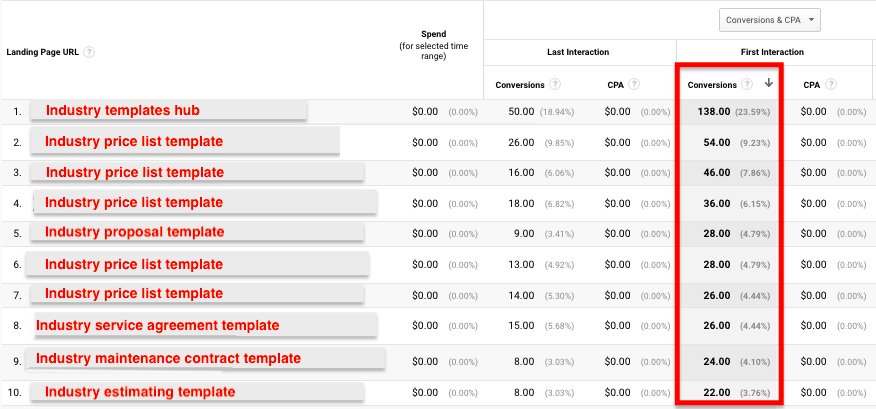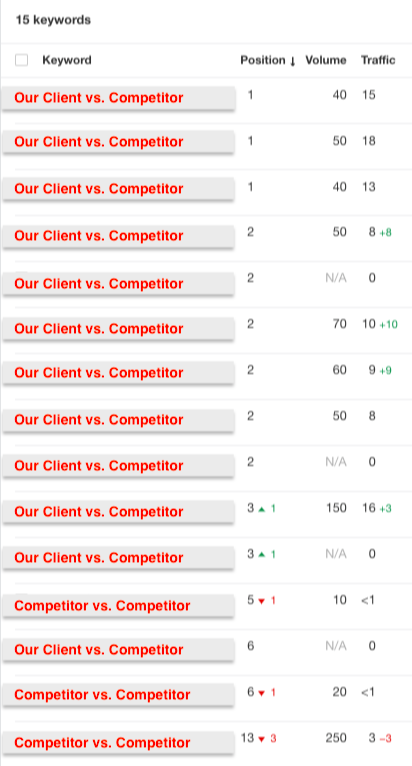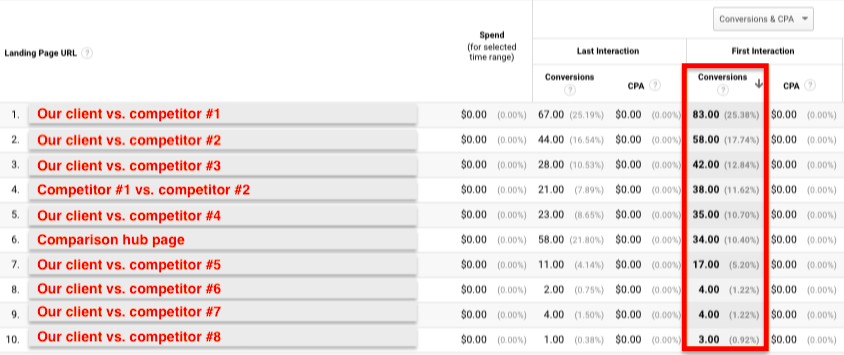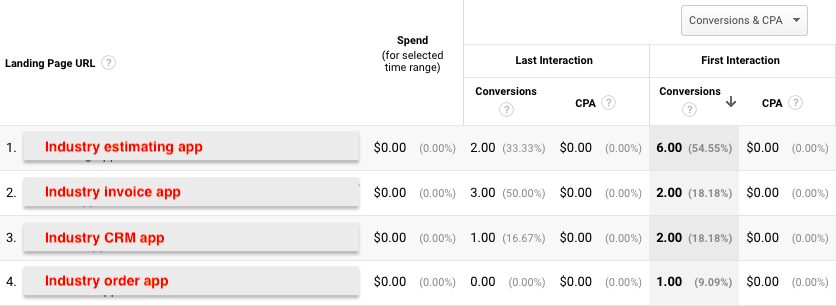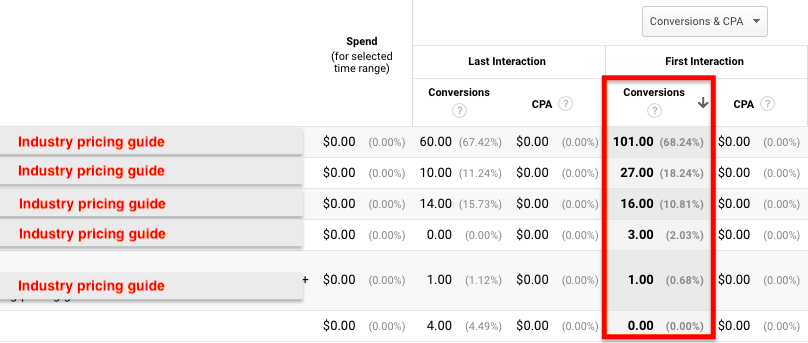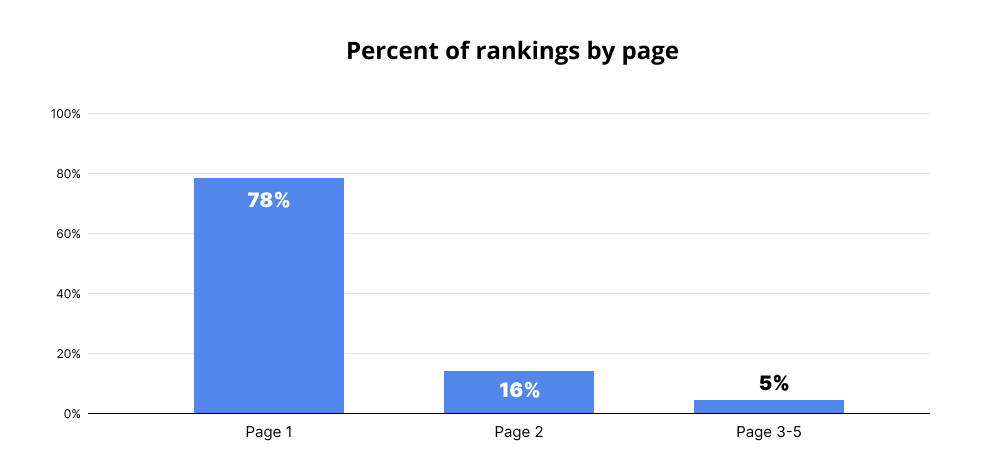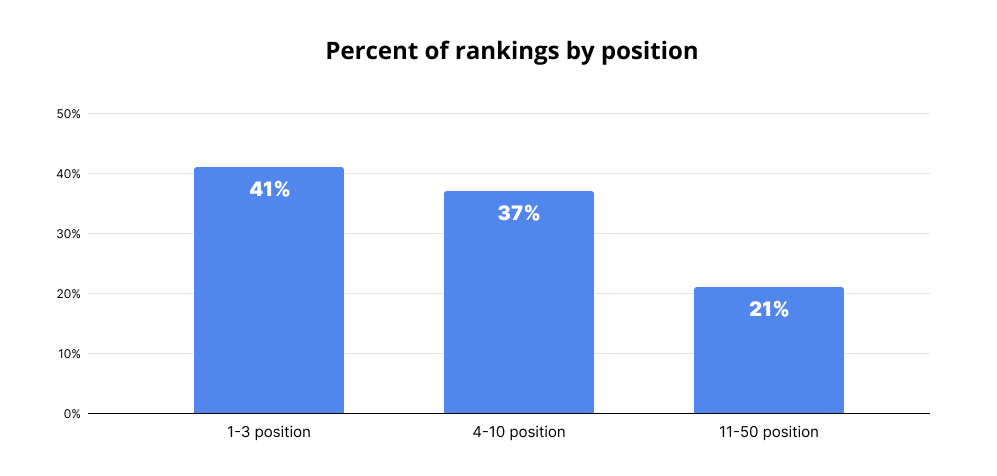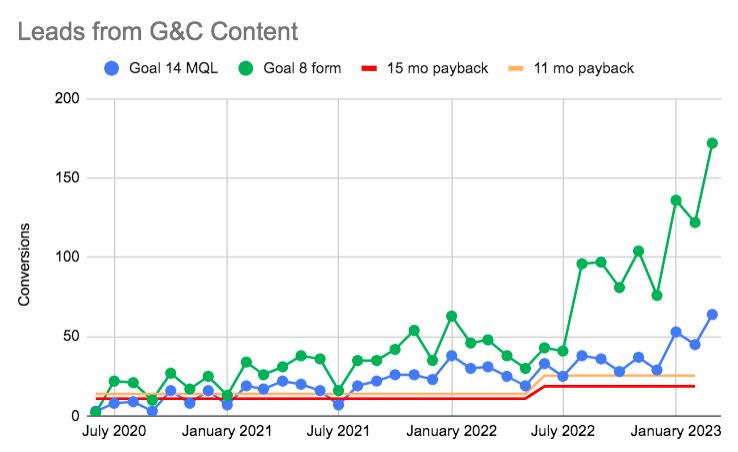[ad_1]
We’ve already shown through countless articles and case studies that focusing on Pain Point SEO keywords — i.e. prioritizing keywords based on buying intent instead of traffic potential — generates far better SEO ROI than standard top of funnel, traffic-chasing SEO strategies.
However, the fact that high-buying intent keywords generate far more SEO ROI than top of funnel keywords is taken to the extreme in all-in-one software products that are massively feature rich.
By “all-in-one” software, we mean software that does what numerous à la carte solutions do, but in one platform.
For these products, there is a massive opportunity cost to not prioritizing bottom of funnel keywords because, compared to à la carte products, there aren’t just 5, 10, or even 50 high-buying-intent keywords — there are often 200+. So it’s borderline inexcusable to focus on top of funnel, traffic-chasing, brand awareness SEO (e.g. ultimate guides, general how to’s, 10 tips, etc.). Just high-buying-intent keywords alone can satisfy years of content production.
We wanted to write a case study that drives this point home. Specifically, we’ll walk through how we’ve implemented Pain Point SEO for an all-in-one SaaS client that we’ve been working with for almost 3 years. Today, the pages we’ve created are driving 150+ demo requests/month for their business.
Below, we cover:
Why Pain Point SEO Is a Great Fit for All-In-One SaaS Businesses
Grow and Convert’s approach to SEO is to focus on high-buying-intent (bottom of the funnel) keywords first and create dedicated pages to rank for each keyword. This is in contrast to what most companies and agencies do:
- Spend most of their SEO effort prioritizing high search volume, but low buying intent keywords that barely convert.
- Try to rank for many different keywords with individual pages using what we call “The Sprinkle Method” (i.e. sprinkling keywords into pages hoping to rank for several terms).
We cover our approach at length in our original Pain Point SEO post, as well as our posts on SaaS content marketing and SaaS SEO strategy.
But these articles haven’t specifically discussed the value and relevance of this strategy for all-in-one SaaS platforms. Since these platforms have so many features, they have a huge number of buying intent keywords to go after!
For example, this client has a platform with 100+ features, essentially creating a one-stop-shop where their customers can run their entire business from one place. And each feature they offer has numerous high-buying-intent keywords associated with it — e.g. feature + software keywords, feature + app keywords, and long tail variations.
They also serve a variety of different industries (not uncommon for all-in-one SaaS products). This opens up even more keywords because if they go after “industry #1 + accounting software,” they can also go after equivalent keywords for the other industries they serve — and that keeps compounding because they can do that with every feature offered.
Furthermore, every feature has associated pain points, so there’s naturally more pain point keywords to go after, as well.
This is in contrast to à la carte SaaS products (or “point solutions”) that only do a handful of things, and therefore may have a much more limited set of high-buying-intent keywords to target. For example, in the SEO space itself, you can think of this as the difference between an à la carte keyword research tool versus an all-in-one SEO tool like Ahrefs or Semrush. Obviously the latter have a lot more buying keywords to go after.
Don’t get us wrong, we’ve had many à la carte SaaS clients, and Pain Point SEO has worked wonders for them. Most businesses simply underestimate the sheer number of high-buying-intent, bottom of funnel keywords that are available to them. But for all-in-one tools, the value of this approach compounds significantly.
The bottom line: If you’re a SaaS company with a large feature set or all-in-one style platform, Pain Point SEO strategy is a huge opportunity. Yet, as we’ll discuss next, the typical approach for SaaS companies or SaaS SEO agencies does not capitalize on this.
Flaws with the Typical Approach to SEO for All-In-One SaaS Products
Having worked with dozens of clients over the years, we’ve learned that the usual approach to SaaS SEO strategy (that other agencies and in-house teams use) consists of 2 key parts:
- Optimizing Core Website Pages: Optimizing the core pages of their marketing website (i.e. home, feature, solutions, pages) for high-intent, software category keywords (e.g. “accounting software”).
- Producing Blog Content: Creating and publishing some form of blog content on an ongoing basis loosely guided by SEO keywords or using the “sprinkle” method (asking writers to sprinkle certain keywords throughout the posts).
There may also be some link building or technical SEO tactics that happen. But these are generally the 2 key parts to their strategy.
As we discussed at length in a previous article, there are 3 core flaws with this approach:
- Flaw #1: Core site pages may rank for a couple of important keywords, but it’s difficult to rank home, feature, and solutions pages for many high-value software category keywords because these pages:
- Have limited space to include relevant SEO keywords.
- Are first and foremost meant to explain your features and solutions (not meet the search intent of specific keywords).
- Don’t typically mention competitors, however, ranking in the top few spots for software category keywords often requires including lists of software options.
- Flaw #2: There are way more high-intent keyword opportunities than you can reasonably rank for with your features and solutions pages.
- Flaw #3: Blog content isn’t used strategically to rank for valuable keywords and drive product signups. (It’s typically used for chasing top of funnel traffic that results in low to zero attributable conversions).
The implications and opportunity costs of this approach are particularly significant for all-in-one SaaS products because they have so many more valuable keywords to go after.
Let’s take a look at what can be achieved when using our Pain Point SEO strategy through the lens of our work with an all-in-one SaaS client.
How We’ve Grown Demo Signups to 150+/Month for Our Client
For context, this client is an all-in-one SaaS platform valued at over $5B. They offer a comprehensive feature set including scheduling, CRM, mobile app, time tracking, payroll, invoicing, payments, reporting, marketing, and more.
They serve 20+ industries, but we’ve focused almost entirely on their three highest priority verticals. This means that for most keywords we’ve gone after, we’ve created dedicated pages to target the equivalent version of that keyword for each of the 3 core verticals.
For example, if we went after “[industry #1] invoicing app”, we’d also go after “[industry #2] invoicing app” and “[industry #3] invoicing app.” As you can imagine, this opened up a huge number of keyword opportunities.
There are several competitors in their space, so we’ve also had many competitor comparison keywords to go after.
While we usually prioritize going after software category keywords (e.g. “CRM software”, “time tracking software”, etc.), in this case, our client has targeted these keywords with product landing pages built in-house.
Important note: Many SaaS websites don’t have the domain or topical authority to rank for these types of buying-intent software category keywords with product pages for reasons we discussed above. This particular client does have the domain and topical authority to rank for these; for many businesses that don’t, blog posts will likely get you to rank higher or faster (or both) for these keywords.
The Types of Keywords We’ve Prioritized
Ultimately, we’ve focused on the following 4 types of keywords:
- Template keywords
- Competitor comparison keywords
- Apps keywords
- Mid and top of funnel pain point keywords
Let’s look at examples of each.
Template Keywords
In SaaS, it’s well known that almost every software product replaces a clunky, patched together system of Google Docs, Excel spreadsheets, PDFs, and miscellaneous apps that customers have been using to get by. And very often, these people search online for templates to help their patchwork system (for example, “Excel CRM template” or “PDF template for invoicing”).
These turn out to be really valuable keywords to rank for because people searching for them have a problem that your software happens to solve. (They’re just using a patchwork system to solve it right now.)
If your product does that particular thing the person is searching for, it presents a valuable opportunity to show up in search results, provide them with a free template, and explain how your product makes this process even easier and more effective.
In this particular client’s space, there is huge demand and search volume for business document templates from their customers.
For example, their customers are searching for templates, such as:
- [industry] invoice template
- [industry] estimate template
- [industry] proposal template
- [industry] price list template
Several months into working with this client, we began testing out some template keywords in the following format: “[industry]
We’d offer a free template that our client would create, point out the shortcomings and process-related issues of relying on a static PDF template to perform that business function, and provide an in-depth walkthrough of how our client’s product solves those issues.
From both rankings and a conversion standpoint, the results have been incredible. At the time of this writing, we have:
- 10 templates ranking in positions 1-3
- 23 templates ranking on page 1
And, as you can see below in this sample of our top 10 converting template pieces, these posts have driven a significant number of demo requests over the course of our engagement:
Competitor Comparison Keywords
Competitor comparison keywords are some of the highest-buying-intent keywords.
If someone is searching for your brand versus a competitor — or competitor alternatives — they’re clearly indicating they’re in the market for what you sell. This is a crucial time to show up, tastefully discuss the differences between your product and your competitors, and to sell to prospects right before they make a purchase decision.
As we mentioned above, this client has several competitors in their space. So, we’ve gone after competitor keywords in a variety of ways, including:
- Head-to-head comparisons: We’ve gone after “[Our client] vs. [competitor]” keywords with long-form pieces that walk through our client’s strengths and unique differentiators compared to that competitor (based on interviews with their sales, product, or competitive intelligence teams).
- Three-way comparisons: We’ve targeted keywords where people are searching for “[Competitor] vs. [Competitor]” and added in “vs. [our client]”. This allows us to insert ourselves into that discussion and sell our client’s unique strengths compared to those services.
- Alternatives pieces: We’ve gone after “[competitor] alternatives” keywords with list articles that feature our client at the beginning. Within those pieces, we link to the in-depth comparison pieces we’ve written on each of the other competitors.
These have also been some of our highest performing keywords. Of our head-to-head and three-way comparisons, we have:
- 11 pages ranking in the top 3 positions
- 14 pages ranking on page 1
And despite many of these comparison keywords having relatively low search volume, we see a significant volume of demo signups from these pages due to the high buying intent.
Here’s a look at our top 10 highest converting comparison pages in Google Analytics:
Apps Keywords
When people search for SaaS products, sometimes they use the word “software”, but other times they use the words “apps” or “tools”. In many cases, there are opportunities to go after the “apps” and “tools” equivalents of software category keywords like those we discussed above (e.g. feature + software, industry + software, etc.).
Important note: You can sometimes target these keywords with a single page, but we often find that dedicated pages work better for getting top positions for each variation. To decide whether it’s necessary to create a separate page, take a look at the top SERPs: see if search results show different results in the top rankings for those keyword variations. If they do, it’s an indication that a dedicated page would likely work better for ranking for each term.
More recently in our engagement, we’ve begun tackling several “
Here’s a look at our apps keywords ranking in the top 5 positions:
These posts are increasingly beginning to contribute to demo signups.
For example, in February 2023, our apps pieces resulted in 12 demo signups (a small but growing number of demo requests):
Mid and Top of Funnel Pain Point Keywords
The nature of a multi-year engagement (particularly with a client that’s ranking for many of their highest buying intent software category keywords) is that over time, we’ll inevitably tackle mid and top of funnel keywords.
Yes, we still tackle top of funnel keywords, as discussed in our case study on scaling content. We just don’t prioritize them over bottom of the funnel, high-buying-intent keywords (particularly in early stages of an engagement) for reasons we’ve discussed for years.
However, the key differences in how we choose these are that we: (a) ensure the keyword has a direct feature tie-in and (b) incorporate and sell the heck out of the product throughout the piece.
Here’s an example of a top of funnel keyword we targeted:
[Industry] pricing guide
Pricing services correctly is one of the biggest pain points for our client’s customers. So we created a pricing guide that walked through the pain points of pricing services in this industry, and how our client’s product helped solve those.
Despite being a lower intent top of funnel piece, this has ranked in position #1 and produced 150+ demo signups to date:
Importantly, even though these pieces are what we call “top of funnel” — in that the act of googling that term doesn’t automatically indicate the reader is in the market for our client’s product — we still sell our client’s software (and its benefits and differentiators) in these articles.
This is a big shift away from the standard content marketing advice of “give, don’t ask” where you shy away from “being too salesy”. We lean into being salesy, not in a cheesy or pushy way, but in a helpful and authentic way. We tie in the product to the topic at-hand and show how, in this case, it can help with pricing, invoicing, and more.
Summary of Results: Keyword Rankings and Conversions
Since the beginning of our engagement with this client, we’ve produced 120+ pieces of content — each tailored to rank for a specific, valuable keyword.
Today, around 80% of these pages rank on page 1 for their target keyword, with the remaining pages mostly ranking on page 2:
It’s also important to keep in mind that the keywords ranking on pages 2 and further are mostly recently published pieces that just need time (or links) to make it to page 1.
The key takeaway? The vast majority of pages we create for this client end up on page 1 for their target keyword.
Furthermore, a significant share of the pieces we publish end up in the top 3 positions, as shown here:
This is meaningful because, in our experience, the top 3 positions are where the majority of conversions come from, and the ability to show up there makes a huge difference in lead generation and ROI from SEO.
Finally, as shown in this graph, these rankings and content have resulted in significant demo signups (in green) and MQLs (in blue) over time:
As you can see, our content is now producing over 150 demo signups/month, and somewhere between 30-50% of these are considered good, qualified leads (MQLs) by our client.
Furthermore, one interesting takeaway from this graph is the inflection point that happened around the two year mark — demo signups spiked over 100/month and have continued to grow ever since.
Despite having been working together for nearly 3 years, we are still finding tons of valuable high-buying-intent and mid funnel pain point keywords to go after. As we tackle and rank for these keywords, our clients’ monthly and net ROI will continue to grow, demonstrating the compounding value of SEO over time, particularly for all-in-one SaaS products.
More Grow and Convert Case Studies
Here are 5 other case studies, each with unique insights, that you can read to see how we’ve executed our SEO strategy for other businesses:
- How We Scaled Leadfeeder’s Signups to Over 200/month
- Scaling Content: Expanding from Bottom of Funnel Content to Top of Funnel (Geekbot Case Study)
- Scaling SEO Traffic from 920 to 14,577 Sessions in 6 months: Circuit Case Study
- How to Do B2B Content Marketing without Domain Expertise (Rainforest QA Case Study)
- How to Create a Keyword Strategy for a New, Innovative Product (Case Study of a video editing software client)
How to Work With Us or Learn More
- Our Agency: If you want to hire us to execute a content-focused SEO strategy, learn more about working with us here.
- Join Our Team: If you’re a content marketer or writer and would love to do content marketing in this way, we’d love to have you apply to join our team.
- Our Content Marketing Course: Individuals looking to learn our agency’s content strategy and become better marketers, consultants, or business owners can join our private course and community, taught via case studies, and presented in both written and video content formats. We include several details and examples not found on this blog. Our course is also built into a community, so people ask questions, start discussions, and share their work in the lesson pages themselves, and we, along with other members, give feedback. Learn more here.
[ad_2]
Source link


